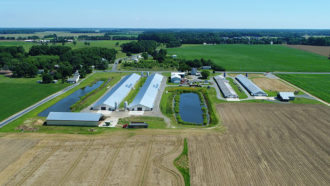Like many farms across the region, Hill Farms, Inc. in Houston, Delaware has seen in increase in residential development surrounding their farm. Because maintaining positive neighbor relations is important to this poultry operation, owner Tina Hill conducted a Northeast SARE Farmer Grant project to install a mixed vegetative buffer adjacent their poultry houses. Tina was interested in creating a buffer that was cost-effective, provided habitat for pollinators, was aesthetically pleasing and reduced odor, dust and noise from the poultry houses. Because the Hills raise vegetables, Tina was also interested in ways to attract native pollinators to the farm in lieu of renting honeybee hives.
A number of early-, mid- and late-season ornamental perennials were installed to provide nectar throughout the season. Clover and sunflowers were also planted to provide additional pollinator habitat and floral resources. During spring establishment, the plantings were irrigated, mowed and weeded, but were maintenance-free during the rest of the season.
A group of FFA students were recruited to provide pollinator counts and found that the number and diversity of pollinators in the vegetative buffer exceeded those found in the grass only control.
Tina said, “The results of the pollinator plot have been mostly positive. Many visitors to the farm have commented on the pretty wildflowers and habitat that have been created by the planting of the wildflowers. Bees, butterflies, and many different types of insects are visiting… [and] the pollinator patch has become the main attraction, not the poultry houses.”
While Tina suggests that professional installation of vegetative buffers may be cost prohibitive to many Delmarva farmers, she believes the benefits outweigh the costs over the long haul.
